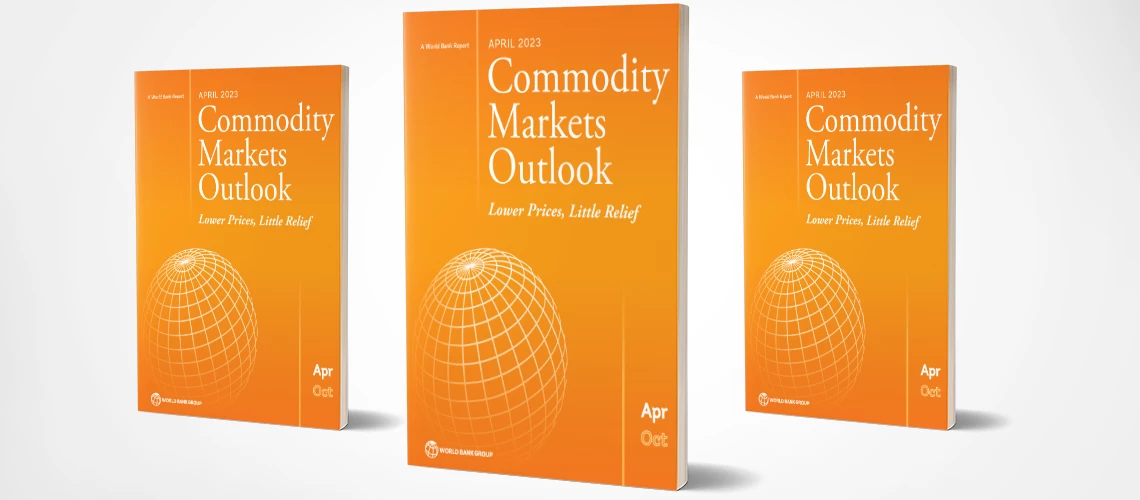 Commodity Markets Outlook Report
Commodity Markets Outlook Report
This blog is the first in a two-part series on commodity market developments, elaborating on themes discussed in the April 2023 edition of the World Bank’s Commodity Markets Outlook.
Commodity prices are expected to fall by 21 percent this year and remain mostly stable in 2024. The expected decline in prices for 2023 represents the sharpest drop since the pandemic. Energy prices in 2023 are expected to be 23 percent lower than 2022 on average and remain broadly stable in 2024. The risks to the forecast are tilted to the upside, primarily because many of the factors that have caused shocks to commodity markets in recent times are still present. These factors include possible disruptions in the supply of energy and metals (in part due to trade restrictions), intensifying geopolitical tensions, a stronger-than-anticipated recovery in China’s industrial sector, and adverse weather events. Disappointing global growth is the major downside risk.
Global commodity prices fell 14 percent in the first quarter of 2023 and by end-March they were roughly 30 percent lower than their historic peak in June 2022. The decline in prices reflects a combination of slowing economic activity, favorable winter weather, and a global reallocation of commodity trade flows. Nonetheless, prices of all major commodity groups and about four-fifths of individual commodities remain above their 2015-19 average levels.
Oil prices have retreated from their mid-2022 peak and are expected to remain stable through 2023. The Brent oil price is 35 percent below its recent record high in June 2022, despite experiencing volatility in March 2023. The discount on the benchmark price for Russian oil against the Brent price widened in December 2022 following the introduction of a price cap by the Group of Seven (G7) industrial countries. The price of Brent is forecast to average $84/bbl in 2023, mostly reflecting weaker growth prospects in advanced economies. Oil supplies will expand, but at a slower pace due to OPEC+ production quotas and limits on capacity in most other oil-producing regions.
Though falling mineral fuel prices have affected Russian export revenues, Russia’s production and exports have been resilient. Russian oil export volumes since April 2022 have remained steady, although they are expected to decline in the remainder of this year because of the EU’s import ban. Following the war in Ukraine, Russia has increasingly diverted its oil, gas, and coal exports to India and China, while reducing its supply to the EU, the United Kingdom, and the United States.
Natural gas prices have declined amid weaker demand. The European natural gas price benchmark plunged by 80 percent from its peak in August 2022 due to milder-than-expected winter weather, a surge in imports of liquefied natural gas (LNG), and a concerted effort to increase energy efficiency and conservation. Larger export volumes and a redirection of trade routes have enabled both natural gas and coal markets to adjust to disruptions triggered by Russia’s invasion of Ukraine. The decrease in Russian pipeline gas supplies and changes in LNG trade patterns are likely to persist in the long term due to an increased focus on energy security, particularly in Europe.
Supply conditions of key food commodities have improved but risks remain. Renewal of the Black Sea Grain Initiative continued to help grain exports from Ukraine reach global markets. The initiative, better harvests in other major grain-producing countries, and lower energy prices, have helped reduce agricultural commodity prices from their early-2022 peaks. Stock-to-use ratios for grains have fallen but remain adequate. This ratio is a rough indicator of the supply of grains relative to projected demand. Persistent upside risks in global food prices include the possibility of more trade restrictions, intensification of geopolitical tensions, and unfavorable weather conditions such as the emerging El Niño.
Despite retreating global food prices, domestic food price inflation persists. Food prices are expected to fall by 8 percent in 2023 and 3 percent in 2024. Nevertheless, the food price index in inflation-adjusted terms will remain at its second highest levels since 1975—exceeded only by 2022. Moreover, food price inflation across the world remains stubbornly high. In the first quarter of 2023, the global year-on-year domestic food price inflation rate averaged nearly 20 percent, the highest level seen in the past two decades. For emerging markets and developing economy (EMDEs), the figure is roughly the same, although there is large variation across countries.
Metals and mineral prices are expected to remain steady over the forecast period, with upside risks in the long term. Metals and mineral prices gained 10 percent in 2023Q1 (q/q), driven by gains in iron ore and tin. This reflects optimism for a strong recovery in China and improved global growth prospects at the start of the year. Prices are expected to average 8 percent lower in 2023, compared to 2022, and declined further in 2024. Key upside risks to the price forecast include a stronger-than-expected recovery in China’s real estate sector and supply disruptions, including those resulting from trade restrictions. In the longer term, however, the energy transition could significantly lift the demand for some metals, notably lithium, copper, and nickel.



Join the Conversation